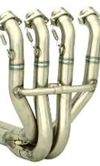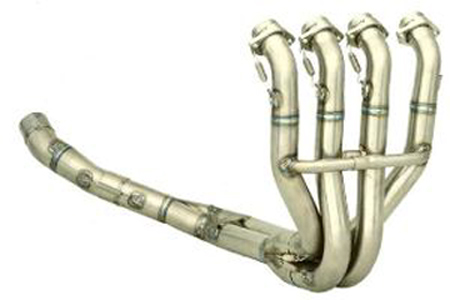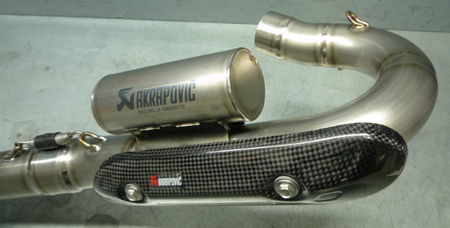Bottles and tubes
 In the world of motorcycle racing, in particular it seems, it has been common to find strange appendages on exhaust systems, on everything from single-cylinder motocross machinery to high-speed inline four-cylinder engines. They can take various forms, common types being:
In the world of motorcycle racing, in particular it seems, it has been common to find strange appendages on exhaust systems, on everything from single-cylinder motocross machinery to high-speed inline four-cylinder engines. They can take various forms, common types being:
1) Tubes linking certain primary pipes together; the link tubes being much smaller in diameter than the primary pipes they connect
2) Larger-volume 'bottles' being used to link adjacent primary pipes together
3) Pipes with closed ends being attached to the side of exhaust systems on single-cylinder exhausts.
We don't see the same things in photos of recent Formula One cars, however, so should we be concerned that the motorcyclists are somehow being conned?
The short answer is no. The aim of most of these devices is to change the shape of the torque curve by introducing different wave reflections into the exhaust at certain engine speeds.
In any given 'plain' exhaust system - that is, without any of the accoutrements listed above - wave reflections arrive back at the entrance to the cylinder as either a positive-pressure 'pulse' or a low-pressure pulse, at a certain time after the initial pressure pulse when the exhaust valve opens. Depending on the speed, these pressure pulses affect how well the exhaust gas is evacuated from the cylinder, and at certain speeds these reflections can be unhelpful, pushing a significant amount of burned gas back into the cylinder.

Thus the charge in the cylinder for the next cycle contains a large percentage of 'residuals'. While we can always expect a certain amount of residual burned gas to remain in the cylinder, large amounts affect the engine output, and we can find large 'dips' in the torque curve where, within a certain speed range, high volumes of residual exhaust gas prevent efficient cylinder filling and combustion.
The devices mentioned above can make a real difference to the torque curve, improving the rideability of the motorcycle. Given the small tyre contact patch a smooth, tractable engine is a bonus in most cases. A dip in a torque curve can cause the rider to open the throttle too quickly and, once out of the 'torque dip' the rapid increase in torque over a very narrow engine speed range can cause the tyre to lose traction. Although this has very little effect on the peak power, the effect on rider (or driver) confidence can mean better lap times.
The 'link tubes' referred to above were used by some teams running V8 engines in Formula One before the rules mandated the use of a V10 engine, but in the modern era it seems that only motorcycle exhausts are widely exploiting the advantage of such devices.

One particular feature of motorcycle racing is that the exhausts are generally supplied by a company whose main business is making aftermarket exhausts for road-going motorcycles. By developing race exhausts that improve the tractability of an engine, they can 'feed' these developments back to their other customers.
Fig. 1 - Link pipes on these Yoshimura motorcycle headers are typical of many current systems
Fig. 2 - This Akrapovic exhaust has a 'bottle' attached to the side of its single header pipe
Written by Wayne Ward